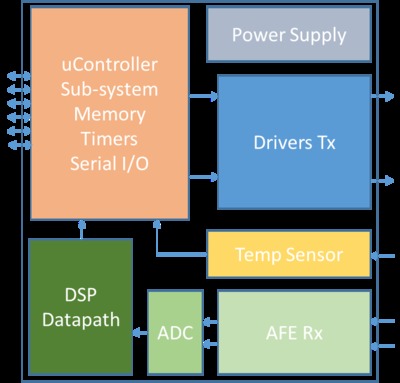Algorithm modelling for parking sensors
Monday, 28 October, 2013
A global vendor of automotive AMS ICs contracted ASTC consulting on algorithm design and feasibility for a next-generation automotive parking assistance sensor ASIC program, a derivative of the predecessor ultrasonic sensor transmit/receive (Tx/Rx) signal conditioner system chip.
ASTC design consulting services and ASTC VLAB ESL technology were used to model and analyse DSP algorithms for an automotive parking sensor AMS ASIC, with accelerated architectural exploration and development for the next-generation device architecture.
The team, including client and ASTC consulting, was defining the new architectural specification, considering updates such as improved measurement range, size and simplification for applications, and further looking towards design and verification tasks in the implementation phase.
ASTC/VLAB Works engineers partially modelled system components like the transmitter/receiver, channel and DSP signal paths. Understanding their properties and performance was critical to redefine this next-generation ASIC. Analysis of proposed IQ demodulation and sigma-delta ADC techniques impact on performance also helped in specifying the required LSD (low side driver), LNA (low noise amplifier) and further DSP configurations. VLAB was used to build the entire algorithmic and system-level ultrasonic sensor model, with standard Python language support, for very complex models, flexibility in system configuration, user interface for running the system and system analysis.
ASTC’s broad, multidisciplinary expertise was key, including automotive sensor ASIC applications, AMS architecture exploration and design methodology, ready availability of off-the-shelf modules and templates for ESL modelling, advanced VLAB solutions and ESL expertise, especially with Python and Python libraries for scientific computations and data analysis integrated in VLAB.

Imagine an automobile with surrounding objects or obstacles, for example, between 0.2 and 10 m. From the virtual platform, Tx sends out an ultrasound signal which travels away to the object that reflects it. The channel, ie, signal travelling path, introduces a Doppler shift, noise and attenuation into the receive path, all distorting the Rx signal. The signal arrives back to the Rx side and all effects are processed and analysed via LNA and ADC followed by a DSP algorithm.
Solutions used included VLAB, an environment for Python algorithm and system model development, debug and simulation, the numerical and scientific computations python toolbox, a model components library and an integrated ESL sensor system model platform.
Engineers from ASTC consulting services, using VLAB and Python technology, delivered the system model and DSP signal path. The system included functionality for an ultrasound Tx/Rx system with a moving transducer, a Tx sine wave bouncing off the fixed target object, a returning Rx sine wave with Doppler shift and distance/speed estimation via DSP. The VLAB DSP dashboard analysis shows the Doppler shift effect on Ultrasound Tx/Rx system, plots both Tx and Rx signals, as well as each step of DSP operation phases.
Block models included: Tx with sine wave; channel; Rx analog LNA gain and sigma-delta modulation; Rx signal envelope detection DSP; IQ demodulation DSP.
DSP dashboard parameters related to channel were analysed in VLAB, showing how the signal is distorted by attenuation and noise through the channel, how the vehicle’s speed adds the Doppler shift frequency on Rx, and distance, which affects the vehicle’s speed estimation via DSP operation. The DSP dashboard for Tx signal parameters shows that the signal is a sine wave defined by the ultrasonic frequency and is in the range of 40 to 100 kHz. The sampling frequency is important to send sampling data for Rx ADC. The burst time is critical both for computing the Doppler shift effect and ensuring the signal has arrived at the receiver (Rx) side.
The DSP dashboard parameters for IQ demodulation analyse the Doppler shift frequency obtained from the Rx signal via DSP operation, where IQ demodulation uses the same Tx signal carrier frequency; the low pass filter (LPF) is designed with a selectable cutoff frequency and 1st to 4th order Bessel or Butterworth filter, to remove the carrier frequency; and the Doppler effect modulated into the Rx signal resulting from the vehicle’s speed is estimated through FFT and finding max frequency values.
The DSP dashboard result for the Doppler effect shows these variables, while all signal plots on the DSP paths are available in both time and frequency domains in the frequency response menu: Doppler shift frequency (Fr) calculated theoretically; Doppler shift frequency (Fp) found from DSP operation; comparison: (Fr-Fp)/Fr %; estimated speed of the vehicle from Fp.
The DSP dashboard features: GUI run control of the system, with DSP parameter changes; plots for all signal stages in both time and frequency domains; design for required filters, to easily extract coefficients; ability to save DSP signal data into files that can be referenced for hardware design and implementation; loading, saving and restoring configuration files for all DSP parameters; and DSP diagram images for the system description and hardware design.

Project goals were met with architectural analysis, algorithm development and implementation, using the advanced new DSP dashboard capabilities. It promoted design re-use and leverage, using the existing chip to jump-start the next generation.
Modelling work delivered during the architecture definition phase, using VLAB and Python for high-level modelling of DSP signal processing algorithms and digital filter designs, can next be highly leveraged in the subsequent ASIC hardware development. VLAB Python models are easily combined with more detailed VLAB SystemC design models, to simulate the system via a real hardware-like interface and registers (for read/write) within the VLAB environment, along with a GUI window where users can also configure and check system performance.
Sweat sensor sticker monitors vitamin C in real time
Researchers have developed a battery-free electronic sticker designed to monitor vitamin C levels...
Flexible optical sensor detects pressure and location
Researchers have developed a multi-channel optical sensor that is capable of detecting both the...
Wearable sensor monitors sweat in real time
Researchers have developed a non-invasive, wearable sensor that can identify and track lactate in...






